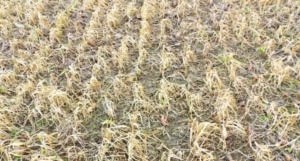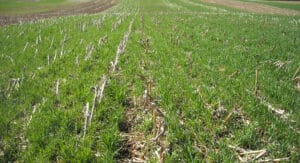NRCS, Plant Materials Program
May 2020
Source link here.
Eric Lee-Mader, Anne Stine, Jarrod Fowler, Jennifer Hopwood and Mace Vaughanby – Xerces Society for Invertebrate Conservation with contributions from the USDA Natural Resources Conservation Service
August 2017
Laura Lindsey, Raj Shrestha, Gregory McGlinch, Steve Culman, Mark Loux, Pierce
Paul, and Eric Stockinger – The Ohio State University
February 2020
Management of Ohio Winter Malting Barley
Source link here.
Collaboration of MCCC Board of Directors
May 2020
Cover Crop Termination Guidelines for Unfavorable Spring Weather Conditions
Midwest Cover Crops Council (MCCC-117)
This publication is intended to provide a starting point for farmers who are new to growing cover crops. With experience, farmers may fine-tune the use of cover crops for their systems.
The following recipe provides an introductory approach to integrating a cover crop into a soybean-corn rotation. Often the easiest place to begin is to plant a cover crop ahead of a soybean cash crop following corn, so consider starting with the companion recipe titled Post Corn, Going to Soybean (publication MCCC-116; see Resources).


Pure live seed (PLS) indicates the amount of seed in the container that is capable of developing into seedlings. To calculate PLS, the percentage of pure seed listed on the seed label of a cultivar is multiplied by the percent germination (also listed on the seed label). For example: 90% pure seed of the cultivar x 80% germination = 72% PLS.
To determine how much seed to plant, divide 100 by the percentage PLS (72 in this example): 100 ÷ 72 = 1.4. Therefore, 1.4 pounds of seed with a purity of 90% and a germination of 80% would be needed for each pound specified in the desired seed mixture.
Post Corn, Going to Soybean: Use Cereal Rye (Ohio Cover Crop Recipe series, MCCC-116)
Herbicide Rotation Restrictions in Forage and Cover Cropping Systems (University of Wisconsin Extension publication)
Calculating the Price of Pure Live Seed (PennState Extension website)
Cover Crop Selector Tool —available from Midwest Cover Crops Council
Using Cover Crops to Convert to No-till (Ohio State University Extension Fact Sheet SAG-11)
Understanding Soil Microbes and Nutrient Recycling (Ohio State University Extension Fact Sheet SAG-16)
Sarah Noggle, Ohio State University Extension; and James J. Hoorman, Hoorman Soil Health Services (Note: This publication was adapted with consent from MCCC under a joint project to produce customized introductory guidance about cover crops for all member states/provinces.)
Jason Hartschuh, Ohio State University Extension; Eileen Kladivko, Purdue University; Anna Morrow, Midwest Cover Crops Council; Eric Richer, Ohio State University Extension; Alan Sundermeier, Ohio State University Extension
January 2020
The U.S. Department of Agriculture (USDA) prohibits discrimination in all its programs and activities on the basis of race, color, national origin, age, disability, and where applicable, sex, marital status, familial status, parental status, religion, sexual orientation, genetic information, political beliefs, reprisal, or because all or a part of an individual’s income is derived from any public assistance program. (Not all prohibited bases apply to all programs.) Persons with disabilities who require alternative means for communication of program information (Braille, large print, audiotape, etc.) should contact USDA’s TARGET Center at (202) 720-2600 (voice and TDD). To file a complaint of discrimination write to USDA, Director, Office of Civil Rights, 1400 Independence Avenue, S.W., Washington, D.C. 20250-9410 or call (800) 795-3272 (voice) or (202) 720-6382 (TDD). USDA is an equal opportunity provider and employer. ©2020 by MCCC. All rights reserved.
Midwest Cover Crops Council (MCCC-116)
This publication is intended to provide a starting point for farmers who are new to growing cover crops. With experience, farmers may fine-tune the use of cover crops for their systems.
The following recipe provides an introductory approach to integrating a cover crop into a corn-soybean rotation. Planting a cover crop ahead of a soybean cash crop is often the easiest way to introduce cover crops into your rotation.

For more information on calculating pure live seed (PLS), visit Calculating the Price of Pure Live Seed, a Penn State Extension website.
Herbicide Rotation Restrictions in Forage and Cover Cropping Systems (University of Wisconsin Extension publication)
Cover Crop Selector Tool, — available from Midwest Cover Crops Council
Sustainable Crop Rotations with Cover Crops (Ohio State University Extension Fact Sheet SAG-9)
Timing of Cover Crop Termination and Related Factors (University of Nebraska–Lincoln website)
Managing Cover Crops: An Introduction to Integrating Cover Crops into a Corn-Soybean Rotation (Purdue Extension publication AY-353-W)
Sarah Noggle, Ohio State University Extension; and James J. Hoorman, Hoorman Soil Health Services (Note: This publication was adapted with consent from MCCC under a joint project to produce customized introductory guidance about cover crops for all member states/provinces.)
Jason Hartschuh, Ohio State University Extension; Eileen Kladivko, Purdue University; Anna Morrow, Midwest Cover Crops Council; Eric Richer, Ohio State University Extension; Alan Sundermeier, Ohio State University Extension
January 2020
The U.S. Department of Agriculture (USDA) prohibits discrimination in all its programs and activities on the basis of race, color, national origin, age, disability, and where applicable, sex, marital status, familial status, parental status, religion, sexual orientation, genetic information, political beliefs, reprisal, or because all or a part of an individual’s income is derived from any public assistance program. (Not all prohibited bases apply to all programs.) Persons with disabilities who require alternative means for communication of program information (Braille, large print, audiotape, etc.) should contact USDA’s TARGET Center at (202) 720-2600 (voice and TDD). To file a complaint of discrimination write to USDA, Director, Office of Civil Rights, 1400 Independence Avenue, S.W., Washington, D.C. 20250-9410 or call (800) 795-3272 (voice) or (202) 720-6382 (TDD). USDA is an equal opportunity provider and employer. ©2020 by MCCC. All rights reserved.
Sarah Noggle – The Ohio State Uniersity Extension
February 2019
James Hoorman, Rafiq Islam, Alan Sundermeier- Ohio State University Extension; Ray Archulleta- Natural Resource Conservation Service; and David Brandt- Ohio No-till Council and Farmer
June 30, 2016
ECO Farming in the 21st century: Improving farm profitability and the environment
James Hoorman, Alan Sundermeier, Rafiq Islam- Ohio State University Extension
May 18, 2015